Some trainers do not recommend doing forearm exercises in the gym. They claim that forearm muscle growth is largely determined by genetics, and that little can be done to improve this muscle group. What's true in this affirmation? Can you exercise the forearm?
The truth is that the forearms are involved in all core exercises (and even squats for the legs). You train your forearms every time you perform a bench press movement, pull-ups, back rows, shoulder presses... The forearms get a lot of work in all the exercises, even if you don't do specific movements to exercise them. Yes, also, the forearm is one of those areas of the body very marked by our own genetics. In other words, if our forearms are too small, we won't be able to do much to increase their size (even if we put all our effort into it). Something similar happens with the abdominals or the twins.
So should you strengthen your forearm with exercises ?? Each person is different, so you must see how this muscle responds to training. If your forearms are already naturally strong and large, you may not need to work them. If not, you can try adding some extra exercises to your workout. The forearm (like the abdominals and calves) has a type of special and very resistant fibers. Keep in mind that the abdominals keep us upright continuously, the calves support the entire weight of our body and the forearms need great resistance to grab all kinds of objects. Therefore, the muscle fibers of these areas of the body have an extraordinary recovery. It is said that it is possible to train abs, calves and forearms with exercises every day. They are muscles that simply they recover well from one day to the next. As a counterpart, the growth of these muscles is very limited. It's very difficult to bulk up your calves and forearms, or bulge your abs, if you're not genetically blessed. Yes indeed, progressing in the forearm exercises will help you become stronger in all the other movements, so give the following a try.
List of the best exercises for the forearm
When you do intense exercises like pull-ups, deadlifts, or bent-over rows, you often feel your forearms burn . This is usually the first muscle group to fatigue, so grip strength is often a weak spot for lifters. When you deadlift a 200kg off the ground, your grip is almost always the first to fail, not the strength of your muscles. Of course, you can solve this problem by using some hand straps (which are a very good help). However, for maximum strength, you'll also want to focus on building forearm strength .
Here, we'll show you the best forearm exercises and detailed information on how to do these exercises, including how to grow your forearms bigger.
Hand roller to strengthen forearm
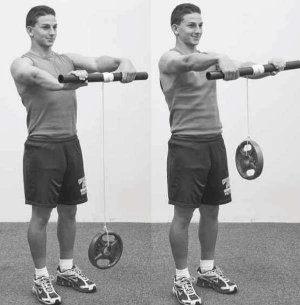
This excellent exercise builds the size, strength, and stamina of your forearm at the same time. The movement is done with a forearm training object , which consists of a stick with a string. At the end of the rope, a disc or weight is tied. With this exercise, you will be able to train both the flexors and the extensors of the forearm (also the deltoids and rotator cuff isometrically). You will notice an incredible pump and burn using only a light weight.
Winding the rope on the bar is one of the best exercises to work the forearm. This object is essential in all gyms. The downside is that if your gym doesn't have one, you're out of luck (although you can easily build one).
How to use the forearm roller:
1. Start with a 2.5, 5, or 10 kg weight plate. With little weight, the movement is already difficult.
2. Stand with your feet hip-width apart and hold the bar in front of you keeping your arms straight. The rope must be fully unwound. The stick or bar should be at shoulder height.
3. Use the strength of your hands and forearms to lift the rope with the weight. Wrap the string completely around the stick.
4. Now again use the strength of your hands to slowly unwind the rope.
Tip: Use less weight than you initially think you can handle. The key to this exercise is to do the movement slowly and in a controlled manner. In this way, the muscles will burn.
Series and repetitions: do three to four series. In each series, wind and unwind the rope several times (or stop when you get tired and can not continue.
This object to exercise the forearm has several advantages. The movement strengthens both the extensors and flexors of the forearm. The thickness of the bar will also help you improve your grip strength. You will focus a lot on the wrists and forearms, which are not usually the main muscles.
Dumbbell Wrist Curl
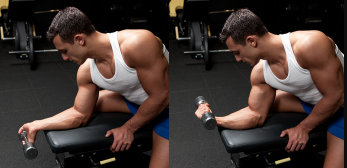
You can do this exercise resting your forearm on a bench or on top of your thighs. You only need a dumbbell and a bench to sit on. This is one of the best moves to train your forearm . The wrist curl exercise is done by gripping the dumbbell with an underhand grip, that is, with the palm of the hand facing you.
How to do the dumbbell wrist curl :
1. Sit on a bench and place your forearm on your thigh or on top of the bench. Your hand and the dumbbell should be above the knee or the bench.
2. Slowly lower the dumbbell as far down as possible maintaining a firm grip throughout the movement.
3. Without lifting your arm off your thigh or bench, bring the dumbbell toward your bicep, then slowly lower the dumbbell to a neutral position.
4. Repeat the movement until you get tired. Then switch hands. Do the same number of repetitions with each arm.
Don't be fooled by how easy this move looks. The exercise is simple and helps strengthen the wrist flexors, which are crucial for building grip strength. It is not necessary to use too much weight. It's best to focus on doing the exercise well with a dumbbell you can control. A good range is 15 to 30 reps.
You can do this exercise alternating each side or with both arms at the same time.
Dumbbell Wrist Extension
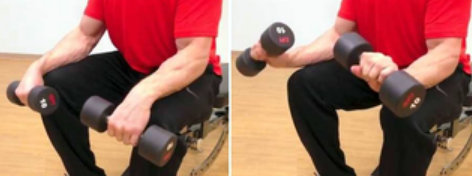
The following is the opposite movement to the previous exercise that we have explained. This is another of the forearm exercises that we recommend. In this case, the dumbbell is held with an underhand grip (the back of your hand should be facing you). Work the upper part of your forearm with this movement. You can do the wrist extension by resting your forearm on the bench or on your thigh. Choose the shape you feel most comfortable with.
How to do the dumbbell wrist extension :
1. Sit on the edge of a bench or chair holding a dumbbell in your hand. The forearm should be straight and resting on the thigh (or on top of the bench, if you prefer this version). The palm of your hand should face down. The hand with the dumbbell should stick out of your knee or the bench.
2. Without lifting your hand from your thigh, rotate your wrist upward to bring the dumbbell as close to your bicep as possible. Remember to maintain a firm grip throughout the movement.
3. Slowly lower the dumbbell to a neutral position.
4. Repeat the movement until you get tired. Then switch sides. Do the same number of repetitions with each hand.
It is the reverse movement of wrist flexion. This extension exercise helps you increase the size and strength of your wrist extensor muscles. You'll find it harder to lift relative to the wrist curl, so use a smaller dumbbell. Focus on doing about 15 or 30 repetitions with each forearm feeling the muscle work well.
You can do the wrist extension alternating each hand or with both arms at the same time.
The clamp or object to exercise the forearm
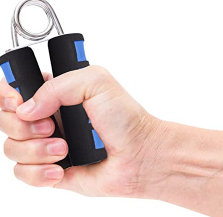
Forearm exercises with grips are great for improving your grip strength and exercising your hands anywhere. You can buy this object to exercise at home. You will actually experience an improvement in your grip strength.
There are several types of objects to strengthen the forearm. You can buy individual clips with different hardnesses. Some objects allow you to regulate different levels of hardness in the same device. It is well worth the investment.
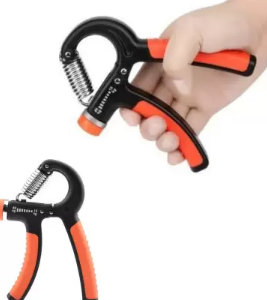
How to use the forearm clamp :
1. Grasp the grip handles with the heel of your hand and fingers. Take a breath.
2. Squeeze your hand hard and try to bring the two handlebars of the object together. Release the air when you make the effort.
3. Keep doing repetitions until you get tired or can't get the handlebars together.
This machine is recommended for all people who require rehabilitation exercises for the elbow and forearm and who need to recover the strength of their hands. A clamp with the appropriate level of effort is also advisable for the elderly (the strength of the hands is lost with age and it is convenient to work on it). This apparatus is the closest thing to a forearm dumbbell .
Pinch weight plates
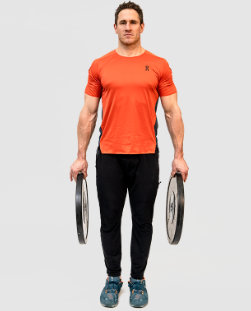
Your fingers are stronger than you think; so strong that some people can scale mountains supporting their entire weight on their fingers. While many forearm exercises in the gym improve overall hand grip strength, this plate exercise improves your ability to pinch objects . You will have strong fingers, thumbs and forearms.
This is a good exercise for a variety of athletes and wrestlers to improve their sport-specific grip strength, and it's also great for powerlifters and Strongmen.
How to pinch the plates :
1. With your fingers, hold a 10 or 20 kg disc. Keep your hands at your sides. Hold on for a while holding the puck.
2. Alternatively, you can hold two or more 10kg plates with the smooth side out. Hold the records with your fingers for a while.
Tip: Make sure your chest is up and your shoulders are down to maintain good posture. The exercise will be more difficult if you walk while holding the weights.
Sets and reps: do three to four sets until you are close to failure and your grip won't hold anymore.
This movement improves the strength of the fingers and thumbs. Squeezing the dumbbell plate increases the strength and endurance of the forearm muscles. This exercise has a direct transfer to the specific grip strength of rugby players, climbers and wrestlers, as well as weight lifters and even Crossfit practitioners.
Hanging from a bar to train forearm
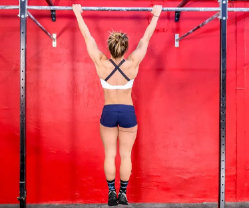
This is one of the best forearm exercises without equipment . You only need a horizontal bar, for example, like the ones in many parks. Also, it does not require a lot of technical skills, but it will certainly give you a lot of physical and mental strength. To do this, you need to jump onto a pull-up bar and hang from it. No, it is not as simple as it seems. You'll need to keep your shoulders back and down and compact to get the most out of your body.
Don't use the mixed grip to hold onto the bar. A normal hand grip will be perfect. The idea is that you stay in the bar for as long as possible . Your forearms are the most important part that will help you to hold on, since it is all about using the strength of the grip, although the exercise will also help you to exercise your hands.
How to hang from the bar :
1. Use a step block or jump to grab the bar.
2. When you are suspended, keep your shoulders back and down. Make sure your midsection is contracted.
3. Hold on to the bar and hang on for as long as you can.
Tip: Don't hold your breath while hanging from the bar. Try to breathe evenly, with all sides of your abdomen.
Sets and reps: Do three to four sets holding until you fail.
The benefits of hanging on the bar are several. To start, you'll build total body strength while holding your body weight. You will be able to transfer this force to movements such as pull-ups or the Muscle-Up. In this exercise, your forearms will be under tension for a long time, since they are mainly responsible for keeping you upright. Hanging on the bar will challenge your grip strength, which will benefit the development of your forearms .
Hold the deadlift
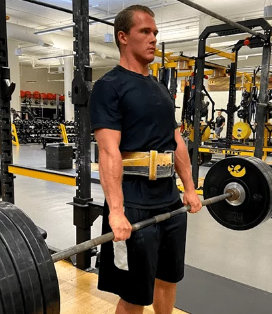
Do you know how to deadlift? In the proposed exercise, you will have to hold the bar for several seconds in the highest position of the deadlift. This will help you a lot to strengthen your forearm and improve your grip strength.
How to hold the deadlift bar :
1. Load the bar with a weight that you could deadlift 10 to 15 reps with. Take a breath and lift the bar off the ground as if you were doing a normal deadlift repetition.
2. When you have raised the bar, do not do another repetition. Instead, hold the bar in your hands for as long as you can until your grip strength is exhausted.
Tip: If you have a power rack or rack, you can pull the bar up above your knees. This way, you won't have to take the bar off the ground with a deadlift. You will focus all your strength on the grip. You can use the mixed grip to hold the bar. With this exercise, you are going to exercise your hands and forearms.
Farmer's walk to exercise the forearm with a dumbbell
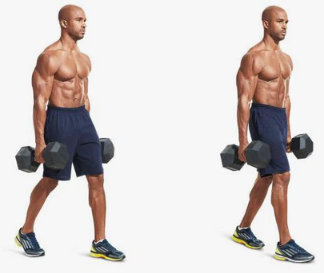
The beauty of this exercise is that you can carry almost anything you can carry in good condition. As long as you can maintain your grip, your stance, and your step, heavy weights will suit you.
What is another advantage of this movement for the forearm? That you can do it with almost any equipment. You can use kettlebells, dumbbells with thick handles, Strongmen's "suitcases" made to measure, bars, sandbags... The list is endless! The more variety of material you give your forearms, the better!
How to carry out the farmer's walk :
1. Take the material of your choice. It can be two heavy dumbbells.
2. Stand up with your hands on each side of your body.
3. Keep your shoulders back and down and tighten your core.
4. Walk at a steady pace for a set time or distance. Rest and repeat.
Tip: Keep your gaze steady and look directly at the ground a few feet away from you.
Series and repetitions: do three to four series of displacements of 30-40 seconds.
The farmer's walk exercise can put a huge load on your forearms, which significantly increases the stress on this muscle group. During the execution of the movement, you will spend a lot of time in a tense position, which is a great way to build muscle. This move can be performed with a variety of weights and equipment, making it very accessible to lifters of various levels.
Fat grip bicep curl
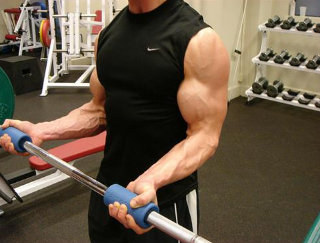
The fat grip biceps curl makes dumbbells and bars more difficult to grip by increasing their diameter. A "fat grip" is a rubber roller that fits around the bar. This roller increases the thickness of the dumbbell handle, forcing your forearms and biceps to work harder. You will train your forearms in two ways, involving your hands with the grip and flexing your forearms.
Depending on your goals, you can use an underhand grip, a hammer grip, or an overhand grip. If you want to increase your grip strength and get huge forearms and biceps, this exercise is for you.
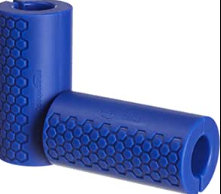 |
| Fat grips are inexpensive and can be attached to any barbell or dumbbell to engage the forearms more in all exercises. |
How to do the biceps curl with "fat grip" :
1. Wrap towels or fat grip rollers around the bar or handle of the dumbbell.
2. Grasp the dumbbell with an underhand, hammer, or prone grip.
3. Raise the dumbbell to your shoulders, until you feel a contraction in your biceps
4. Pause for a second and return to the starting position.
Tip: Focus on extending your finger grip as much as possible while feeling your forearms contract.
Series and repetitions: do three to four series of 15-20 repetitions.
Learn about the benefits of the thick grip bicep curl . This move strengthens your forearms because it challenges your grip with a wider thickness than normal. The thick grip will make it easier for you to lift the weights when you return to the normal grip. The fat grip bicep curl will increase your grip strength, which will transfer directly to other lifts that require hand strength.
Reverse Grip Barbell Bicep Curl
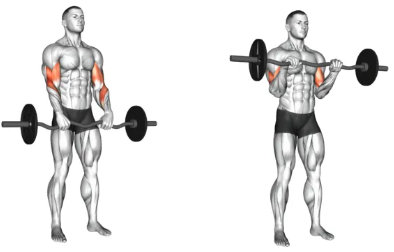
The simple action of reversing the grip can help you increase the size and strength of a neglected part of your forearm. Reverse curls train the smaller extensor muscles of the forearm (the brachioradialis and pronator teres) and the brachialis, the muscles below the biceps, which help make your biceps look bigger when you flex it. An imbalance in the strength of the forearm extensors and flexors can cause elbow pain, so training the forearm extensors is also helpful in preventing injury. Add the reverse curl to your elbow and forearm rehabilitation exercises.
How to perform a reverse barbell biceps curl :
1. We recommend using a Z-bar, which is more comfortable on the hands. Choose a weight that is lighter than what you use for normal barbell curls. Grab the bar with your knuckles facing you.
2. Stand with your feet hip-width apart and your hands at your sides. Roll your shoulders back and down.
3. Keeping your elbows out to your sides, take a breath and slowly bring the bar up to just over 90 degrees.
4. Slowly reverse the movement back to the starting position and repeat.
Tip: You can open your elbows slightly if you feel the most natural range of motion for your limb length. Just make sure that the curl starts from the biceps and mainly from the forearm.
Series and repetitions: do three to four series of 15-20 repetitions.
Use these forearm exercises to increase forearm extensor strength. The reverse grip curl motion will build the size and strength of your forearm and bicep muscles. The barbell reverse bicep curl develops grip strength from a different angle.
Curl 21 with reverse grip
If you've already tried the reverse curl and have done your best to control the movement slowly and the eccentric phase, you can still try a variation of the exercise. There's nothing like a solid set of 21 curls to get the blood flowing and test your mental capacity to keep going.
Do you remember the curl method 21? It consists of doing 21 repetitions of the biceps curl divided into 3 sections of 7 repetitions (without a rest). Each 7-rep segment works a different range of motion from the bicep curl. The first two parts are partial range of motion and the last part is seven reps of a full bicep curl. This will burn the muscle, so do it as the last exercise.
How to do the reverse grip 21 biceps curl :
1. Grasp the bar with a reverse (overhand) grip so your palms are facing down and away from your body. You can do this move with an EZ bar or dumbbells.
2. Do 7 partial repetitions from arms extended to form a 90 degree angle.
3. Do another 7 partial repetitions bringing the bar from the elbows at 90 degrees to the chest.
4. Without resting, perform 7 more reps, this time through the full range of motion (from the bottom position to the top of the reverse curl). You will have completed all 21 repetitions. Take a breath in at the beginning of each repetition and release the air at the end of the repetition.
Tip: Try to keep your arms as stable as possible so the weight doesn't slip above or below your prescribed range of motion.
Series and repetitions: you can do three to four series (with the total of 21 repetitions in each one).
The reverse curl 21 has advantages. This move significantly increases the time your muscle spends under tension.
You force your muscles to fight gravity and momentum with partial range of motion for 14 of the 21 repetitions.
When you use the 21-rep reverse curl system, your forearms burn! Increase the size of your forearm with exercises like this.
Pull-ups with a towel to increase the strength of your forearm
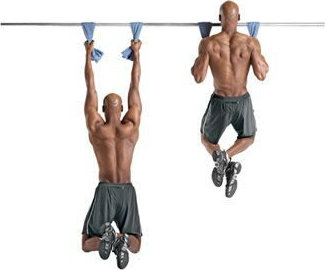
When regular pull-ups are too easy for you, add a towel to make the exercise more difficult. It is more difficult to grab the towel than the bar.
This version of the pull-up will help you exercise your forearm thanks to the neutral grip and the difficulty of holding and pushing yourself with the towel. The increase in strength and size of your forearms will be assured, while you will strengthen your back and biceps.
How to do pull-ups with a towel :
1. You can use one or two towels for this. Using one towel trains the forearms more, while doing pull-ups with two towels will work the lats better.
2. Wrap the towel around the pull-up bar, grabbing it halfway, and holding on firmly.
3. Keep your shoulders down and your chest up until you feel your grip not letting up.
4. Take a breath and use all the strength of your arms and back to raise your body until your chin reaches the bar. Expel the air at the end of the movement.
5. Descend in a controlled manner until your arms are straight. So you will have completed one repetition.
Tip: If you can't fully do a towel pull-up, simply hang on the towel until your grip fails.
Reps and sets: Do three to four sets until you are near failure.
What are the advantages of towel pull-ups in your forearm routine ? This exercise improves the size and strength of the forearm.
A neutral grip puts less stress on the shoulders. You will transfer your grip strength to the other versions of pull-ups thanks to the action of squeezing the towel.
Hammer Bicep Curl
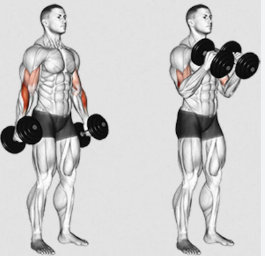
Yes, this movement so well known in gyms is another one of the forearm exercises . It's on our list and for good reason. The neutral grip of the hammer curl is better for the elbows and shoulders than other curl variations. In addition, the neutral grip puts extra stress on the muscles of the forearm and the important but neglected brachioradialis. This muscle stabilizes the elbow during rapid flexion and extension, which is useful if you have to throw an object. Because the neutral grip makes the lift easier, you'll be able to move more weight than in other versions of the bicep curl.
How to do a hammer curl :
1. Hold the dumbbells at your sides with your wrist in a neutral position.
2. Keep your chest up and shoulders down.
3. Keeping your hands neutral, take a deep breath and bring the weights up with your forearm until they are close to the anterior deltoid. Expires at the end of the move.
4. Pause for a second when you get to the top to better feel the work on the biceps. Then slowly lower the dumbbells back to the starting position. Do more repetitions.
Trainer Tip: Once you've mastered this move, try loading heavier dumbbells. This biceps and forearm exercise allows you to lift more weight than a conventional dumbbell curl.
Series and repetitions: do three to four series of 15-20 repetitions.
This forearm weight exercise trains the important and often neglected brachioradialis muscle. The neutral grip is a strong position that often relieves tension in the elbows and shoulders. You can do this curl with more weight to build strength and muscle. You can do hammer curls alternating each arm or raising both arms at the same time (more difficult).
CAN I DO FOREARM EXERCISES ON THE PULLEY?
Although there aren't many specific pulley forearm exercises , you can do some variations of forearm weight exercises that we've listed. You can try the following:
- Reverse grip biceps curl on cable .
- Pulley Hammer Curl .
Behind-the-back wrist curl
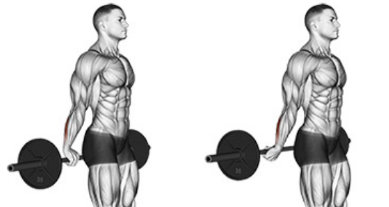
Flexing the wrist behind the back affects the forearm flexors and improves finger strength. Both are important for improving grip strength . The main advantage of this variation, as opposed to the other options, is that it allows you to gradually increase the load.
Start with a light weight and higher repetition rates, but don't be afraid to increase the weight to further strengthen your forearms with this exercise.
How to perform a behind-the-back wrist curl with a barbell :
1. Place a loaded barbell on a rack at knee height and stand with your back to it. If you don't have a rack or training partner, one option is to balance the bar on a bench to get it off the ground.
2. Squat down and grab the bar at shoulder width behind your back. Stand up straight and contract your glutes.
3. Take a breath. Let the bar slide down to your fingertips. Then, bring the bar up and flex your forearms.
4. Exhale and pause for a second in the push-up position before returning to the starting position.
Tip: Try to do the repetitions as slowly as possible and let the bar rest as far below your fingers as possible.
Series and repetitions: do two or three series of 20-25 repetitions.
The barbell wrist curl isolates the forearm flexors with a greater load than other wrist curl options.
You can increase the load progressively. It is one of the best forearm exercises to improve grip and finger strength.
Zottman Curl
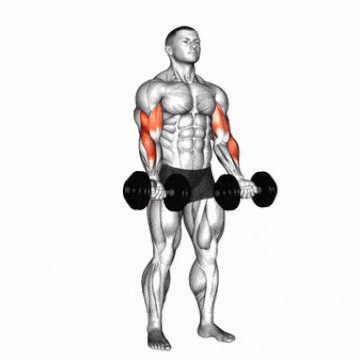
The Zottman curl is like a dumbbell curl, but literally twisted! You start by doing a normal curl with your palms facing up during the concentric part of the lift. However, you rotate your hands during the eccentric part and lower the bar with your palms facing down. This rotation reverses the second half of the lift. Slow down so your muscles are under tension longer, which will develop your forearms.
How to do the Zottman curl :
1. Stand up with a dumbbell in each hand.
2. Take a breath and do a curl with the palms of the hands facing you.
3. At the top of the curl, exhale and turn your palms so they face down.
4. Slowly lower the weights to the bottom of the movement.
5. Rotate your hands again so that your palms are facing up before doing the next repetition.
Tip: Take your time doing the wrist rotations. Go through the movement slowly and focus on the full range of motion.
Series and repetitions: do three to four series of 15-20 repetitions.
Add the Zottman curl to your forearm exercises at the gym . This move works both the biceps and forearms, and is a variation on the dumbbell curl. When you place your palms down during the eccentric phase, the load is supported by your forearms. Adding this dynamic rotation to your curls can help you train hand stability.
Walking holding a kettlebell upside down
Holding the bottom of a kettlebell up is simple, but not easy. Carrying a kettlebell backwards challenges your grip and forearm strength. Flip the kettlebell over so the heavy part is on the handle and the handle is in the palm of your hand. You can use the forearm weights . Kettlebells will force you to use additional muscle fibers and motor units to control the unstable load. Walking holding a kettlebell upside down will help you improve your posture, lateral stability, grip, and forearm strength while strengthening your entire shoulder joint .
How to carry a kettlebell upside down :
1. Find a clear area to walk in, stand up and hold the kettlebell in one hand.
2. Bend your elbow so that the kettlebell is in front of your shoulder, at chin level. Make sure the handle is in your hand; the bottom of the kettlebell should point toward the ceiling.
3. Keep your wrist in a neutral position and your elbow bent at 90 degrees.
4. Hold the weight tightly and walk slowly for a certain distance.
5. Then switch the kettlebell to your hand and go for another walk.
Tip: Keep your shoulders tight, even while holding the weight overhead. Try to keep both shoulders at the same level.
Series and repetitions: do three to four series of 30-40 seconds for each side.
Don't use too much weight because you will require additional muscle tension to hold the kettlebell. With a light load, you can focus more on technique. This very simple movement improves forearm and grip strength due to the instability of the bottom of the kettlebell. Lowering the kettlebell strengthens lateral stability and improves posture and gait.
Walk like a crab exercise
We recommend this movement for those who want to do forearm exercises at home . The crab walk may seem a bit out of place in a weight room, but this bodyweight move can really help you out. You will be in a full bridge position, but moving like a crab, so your forearms will need to improve their stability to support you.
The crab walk will also help you open up your chest, a welcome relief when you've been bench pressing for a long time. These calisthenics forearm exercises may seem a bit silly, but your pelvic and shoulder mobility will appreciate this move. Also your forearms.
How to do the crab walk :
1. Sit on the floor with your knees bent and your feet in front of you.
2. Place your hands on the ground below your shoulders. Press your arms and legs down. Lift your buttocks off the ground. Ensure stability in this position.
"Walk" with the right arm and left leg moving simultaneously. You can move in any direction you want. Simply maintain a number of reps or steps between the sides and directions.
Tip: you have to take short steps. Scroll only a few inches at a time.
Sets and reps: Do the "walks" over time. Perform three to four sets of 30-50 seconds. Remember to change the direction of your walk halfway through each set or keep the sets even.
This bodyweight move helps you build core and forearm strength at the same time. The mobility of your shoulders and hips will increase with practice. Walking like a crab helps you improve your kinesthetic awareness and coordination, which you can easily transfer to complex dumbbell lifts.
Chin-up with three pauses
Doing pull-ups with three pauses strengthens your grip in three different positions. Include this move in your calisthenics forearm exercises . It also helps you improve strength and performance during normal pull-ups. Isometric grips in each position test forearm and grip strength. You will increase the tension time of the exercise and you will exploit the hypertrophy as much as possible to increase the forearm . This exercise is a true test of will. Performing it develops your mental and physical resistance!
How to do chin-ups with three pauses :
1. Stand up with a box or jump to grab the pull-up bar.
2. Grab the bar and come to the final position of the pull-up (with chin above the bar). Stay locked here and hold the position for at least 10 seconds. This will be the first pause.
3. Slowly lower yourself to a position where your elbows are at 90 degrees and stay there for at least 10 seconds. Here, you will make the second break.
4. Lower yourself until your elbows are slightly bent. Make the last pause for at least 10 seconds.
5. Slowly lower down to extend arms and stop.
Tip: If holding the above three positions is too much for you, start with one position for each rep and alternate until you can do them in order.
Sets and reps: Do three to four sets of one rep. One rep means doing all three pause positions.
This pull-up bar forearm exercise has the following benefits. Build bigger and stronger forearms, biceps and back thanks to three different positions. This move will improve your pull-up performance, especially if you suffer from elbow or shoulder problems. The three-pause chin-up provides functional grip strength in a variety of positions, making it ideal for rock climbing.
Are forearm exercises in the gym worth it ? If your forearms are a muscle group that is lagging behind in development, give them a little workout. Here is a good list of efficient exercises. The best is the variety. You can choose between forearm exercises with dumbbells , with a barbell, and even with your own body weight. You don't have to do them all. Select at least two forearm exercises from the list and alternate the options over time.







